Freckle Removers
A smooth, soft, transparent skin was an important attribute for Victorian and Edwardian ladies. This made freckles a much hated skin blemish and treatments to get rid of them were a staple in beauty books of the time. Unfortunately, as more women took up outdoor sports – such as bicycling and sea bathing – freckles became even more of an issue. In other places in the world where Europeans were present and sunlight was more prevalent – such as in the southern United States, Australia and South Africa – the issue had been around for much longer and was more widespread.
The link between freckles and outdoor exposure had long been recognised but the connection was not watertight. Although freckles did appear to be more common on the parts of the body exposed to sunlight, they also occurred on places that were always covered. So, dermatologists and beauty writers of the time often distiguished between ‘warm’ or ‘summer’ freckles and ‘cold’ or ‘winter’ ones.
[Freckles] are far more marked in summer than in winter. They undoubtedly grow darker in color when exposed to the sun; but they occur also upon parts not usually exposed to its rays, as the buttocks and penis. There are no subjective sensations whatsoever. Freckles are more a deformity than a disease, and in many persons of blonde appearance be numerous and dark enough to be very unsightly.
(Robinson, 1885, pp. 366-367)
Freckles are divided into two classes—summer freckles, which usually fall to the lot of fair-skinned light or auburn-haired girls, and are produced almost instantly on exposure to strong light, disappearing in a little while if the subject remains indoors or in the shade. … The other form of freckles is called cold or winter freckles. These never disappear, except through external agencies and then only with the cuticle itself.
(Ayer, 1902, p. 130)
Winter freckles appeared to be located more deeply in the skin and were more difficult to treat. Because of this difference, by the 1920s many dermatologists were restricting the term freckle to the ‘summer’ type, that is those caused by sunlight. It is for these that the numerous freckle recipes listed in beauty books were mainly aimed.
Freckles as rust spots
On occasion, early writers tried to explain to their readers why it was that freckles appeared in summer. Their explanations included: that the spots were due to the carbon in the skin being charred by the sun – in much the same way as sunlight will turn paper brown; and that the freckles were ‘rust patches’ formed by heat affecting oxygen in the skin causing it to combine with iron in the blood to form rust.
Freckles, which many people find themselves troubled with just now, at the close of their summer vacations, are chiefly caused by the iron in the blood which, forming a junction with oxygen, leaves the usual rusty marks! Where the junction has taken place. This explains in a most satisfactory manner the reason why those who have red hair are more liable to freckles than others; for it is ascertained that the red color of the hair arises from a red-colored oil containing iron in excess. As the skin and hair therefore are so analogous in constitution, the iron will of course superabound in both, and be always ready on the least exposure to heat to join the disengaged oxygen and form those rusty spots called freckles.
(Buffalo NY Daily Courier, 1887)
Sunlight
By the early twentieth century it had become generally accepted that freckles were caused by a chemical reaction between the skin and sunlight that affected the pigment cells, and were not caused by charring, rusting, heat or wind. They were an aberration of the tanning process that occurred in people that were susceptible to them, individuals with light complexions or reddish hair being cases in point. The obvious way to avoid freckles was to cover up, but even this led to some unusual ideas, especially when it came to the subject of veils.
According to the present theory, it is not the heat of the sun which develops freckles and tans and bums the skin, but the light from its electrical rays (commonly called actinic, which merely signifies chemical); and it is the difference in the chemical constituents of the pigment in the skin which causes these rays to affect some persons so much more seriously than others. Neither blue veils nor white ones are the least protection, as the electric rays pass directly through them. Red rejects these blue and violet rays, therefore a reddish-brown veil interposes an obstacle; and, of course, a red one is protective, but has only that recommendation. Even fashion can never make a red veil or red gloves other than hideous. The veil habit is a very bad one for the eyes, and if women understood their own advantage and welfare, the manufacturers of spotted-net veiling would go out of business, for not a yard of it would be sold. When a veil is really needed for protection, it should be of gauze or chiffon.
(Fletcher, 1901, p. 173)
Home freckle treatments
Many home freckle treatments used weak acids or mild bleaches. Common ingredients used included lactic acid, lemon juice, vinegar, sour milk, borax and horseradish.
PEARL WATER FOR THE FACE.
Put half a pound of the best Spanish oil soap, which has been cut or scraped very fine, into a gallon of boiling water. Stir the whole well for some time, and then let it stand tiII cold. Now add a quart of rectified spirits of wine, and half an ounce of oil of rosemary; stirring the whole well together.
Remarks.
This compound liquid, when put up in proper phials, in Italy, is called Tincture of Pearls. It is an excellent cosmetic for removing freckles from the face, and for improving the complexion.(Lillee, 1822, p. 336)
Scrape horseradish into a cup of cold sour milk; let it stand twelve hours; strain, and apply two or three times a day.
One ounce of alum, ditto of lemon-juice, in a pint of rose-water.
Prepare the skin by spreading over it at night a paste composed of one ounce of bitter almonds, ditto of barley-flour, and a sufficient quantity of honey to give the paste consistency. Wash off in the morning, and during the day apply with a camel's-hair brush a lotion compounded thus: One drachm of muriatic acid, half a pint of rain-water and a teaspoonful of lavender-water, mixed.
At night wash the skin with elder-flower water, and apply an ointment made by simmering gently one ounce of Venice soap, quarter of an ounce of deliquated oil of tartar, and ditto of oil of bitter almonds. When it acquires consistency, three drops of oil of rhodium may be added. Wash the ointment off in the morning with rose-water.(Wells, 1891, p. 481)
Freckles Rose Water ozs 2 Glycerine ozs 2 Lactic Acid ozs 4 Use several times a day.
(Furlong, 1914, p. 27)
Other treatments
Stronger substances such as hydrochloric acid (muriatic acid) ammonium, hydrogen peroxide and even mercury compounds were also suggested for stubborn cases, although, to be fair, many writers recommended caution with these more dangerous materials.
Another suitable but poisonous lotion which should not be allowed to get into the eyes is made as follows:
MERCURY FRECKLE LOTION Mercuric Chloride 7 gr Zinc Sulphate 90 gr Almonds (blanched) 60 gr Rose Water 8 oz Make an emulsion with the almonds and rosewater. Dissolve the mercury therein and add the oxide. Shake well before using and apply with cotton once daily. If it irritates skip a day.
(Woodbury, 1911, p. 255)
Bichloride of Mercury is the only thing that will positively remove obstinate freckles and discolorations. It is a dangerous poison and should not be brought into the home. Only the smallest amount—a few grains—in many ounces of other ingredients is used in preparations, and if you must take the risk have a reliable druggist put up the prescription for you.
(Furlong, 1914, p. 30)
As the pigment cells lie beneath the horny cells of the epidermis, the removal of freckles, once they have made their appearance, cannot be an easy process. Methods which produce mild scaling of the skin, or more drastic peeling are used. Persistent use of lemon juice bleaches the skin and causes it to peel, as do applications of peroxide solutions applied after the skin has been washed with a strong alkali soap and water has been sponged with ammonium water.
More drastic measures than these require medical skill and necessitate confinement to the house. They consist of spraying undiluted carbolic acid or other strong caustic acid to the pigmented cell. This produces severe inflammation and causes the skin to peel. The treatment lasts for about a fortnight and if applied carelessly or by unskilled hands may produce scars.(Joslen, 1937, pp. 120-130)
Medical treatments
Dermatologists generally did not see freckles as needing treatment but, if pressed, might bleach them with hydrogen peroxide; peel them using salicylic acid, resorcinol or some other substance; or treat individual spots with carbolic acid, liquid carbon dioxide, dermabrasion or even, early on with electrolysis.
See also: The Drilling Machine
Commercial freckle creams
The predominant ingredients used in commercial treatments were mercury compounds such as ammoniated mercury and bichloride of mercury (corrosive sublimate). These were often combined with bismuth or zinc salts, with bismuth subnitrate being a particular favourite. These compounds were also common in ‘bleaching creams’, although chemically they are desquamating agents rather than true skin bleaches.
See also: Mercolized Wax.
Most of the commonly used freckle removers including Stillman’s Freckle Cream, Othine Freckle Remover and Berry’s Freckle Ointment contained mercury compounds. Some of these products were produced in double and triple strength formulations, with levels of mercury compounds that reached 10-15% or more. In the 1940s, after the introduction of the 1938 Food, Drugs and Cosmetics Act, the FDA moved to reduce the levels of mercury compounds to 5% or less and some products were seized and destroyed. This did not mean the end of these dangerous cosmetics and they remained around until the 1970s, when restrictions or prohibitions were placed on the cosmetic use of mercury compounds by the UK, the USA, the EU and elsewhere.
See also: Arsenic-Eaters and Cucumber Creams
Updated: 4th June 2014
Sources
The art of beauty. (1825). London: Knight and Lacey.
Ayer, H. H. (1902). Harriet Hubbard Ayer’s book of health and beauty. New York: King-Richardson.
Buffalo NY Daily Courier (1887).
Fletcher, E. A. (1901) The woman beautiful: A practical treatise on the development and preservation of woman’s health and beauty, and the principles of taste in dress. New York: Brentano.
Furlong, P. (1914). Beauty culture at home. A complete course in shampooing, facial and scalp massage, hair coloring, manicuring, chiropody, developing and reducing—also hundreds of reliable formulas for beauty preparations, including cold creams, skin bleaches, liquid and dry powders, rouges, depilatories for removing superfluous hair, shampoo mixture, hair tonics and restorers, curling fluids, bust developing, reducing, remedies for wrinkles, pimples, blackheads, freckles, liver spots, sunburn, eyes, mouth, hands, feet, exercises, diet and miscellaneous valuable hints—as taught at Paulette School. Washington: Author.
Joslen, S. (1937). The way to beauty. A complete guide to personal loveliness. New York: Pitman Publishing Corporation.
Lillee, C. (1822). The British perfumer: Being a collection of choice receipts and observations made during an extensive practice of thirty years, by which any lady or gentleman may prepare their own articles of the best quality, whether of perfumery, snuffs, or colours (2nd ed., C. MacKenzie Ed.). London: J. Souter.
MacLeod, J. M. H. (1920). Diseases of the skin. London: H. K. Lewis & Co. Ltd.
Nordlund, J. L., Boissy, R. E., Hearing, V. J., King, R. A. , & Ortonne, J. (1998). The pigmentary system: Pathology and pathophysiology. New York: Oxford University Press.
Robinson, A. R. (1885). A manual of dermatology. New York: D. Appleton and Company.
Wells, R. A. (1891). Manners culture and dress of the best American society, including social, commercial and legal forms. Letter writing, invitations &c., also valuable suggestions on self culture and home training. Springfield, Mass: Clark Publishing Co.
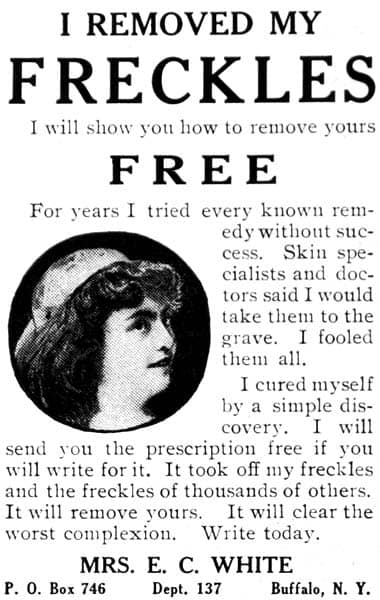
1890 Freckle cure.
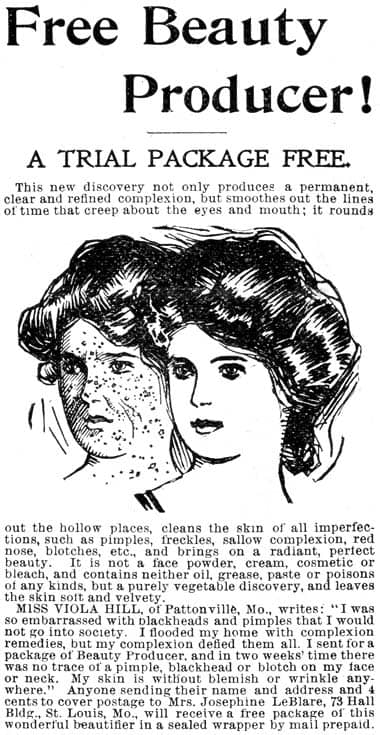
1901 Freckle cure
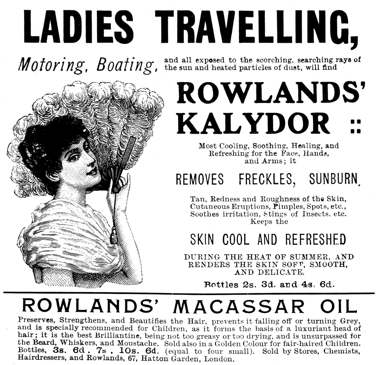
1912 Rowlands’ Kalydor.
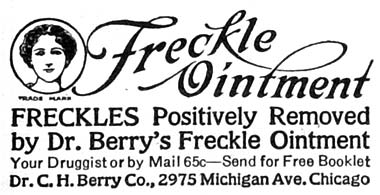
1919 Dr Berry’s Freckle Ointment.
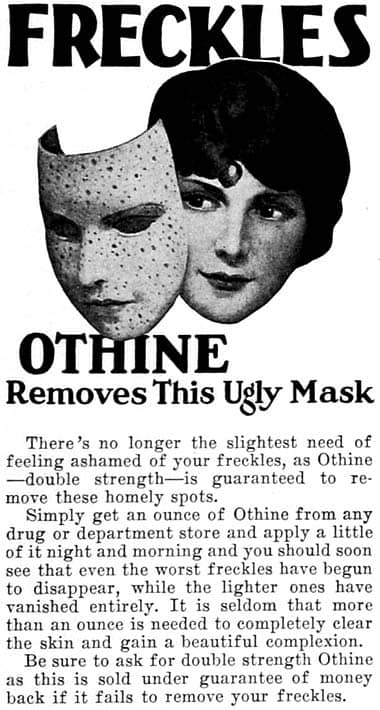
1928 Othine Freckle Remover. It was also available in triple strength.

1929 Stillman’s Freckle Cream. Also made in multiple strengths.
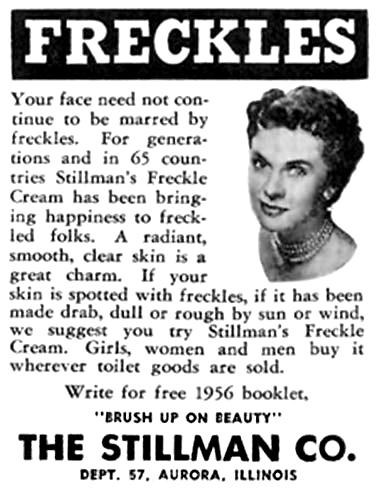
1956 Stillman’s Freckle Cream.
